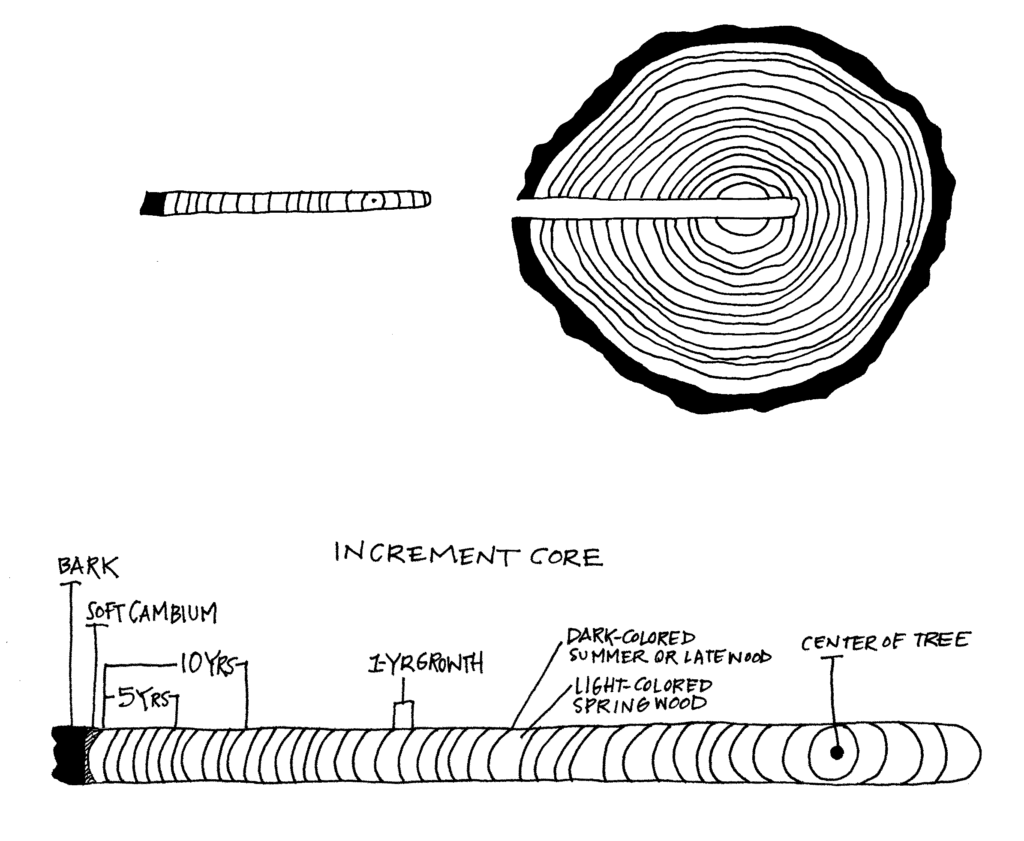4.5: Increment Boring
- Page ID
- 20264
Since counting a tree’s annual rings is a reliable way to estimate its age when records are unavailable, this method has been adapted for living trees. An instrument called an increment borer extracts a small, pencil-sized piece of wood, or core sample, from the trunk of the tree. A mini-auger is drilled by hand from the bark to the center (pith) of the tree, and the resulting core sample extracted from the hole displays the annual rings (or increments of growth) of the tree at that point in the tree (Figure 4.6). The tree then “pitches” the hole over, filling the small cavity with resin.

Figure 4.6. A cross-section of a tree that has been bored, showing the displaced core sample.
The standard location for taking increment core samples from a tree is diameter at breast height (DBH). There are a number of reasons for doing so.
- It is a comfortable height for most people to turn the handle of the increment borer, and to extract the core sample. (Imagine lying on your stomach to try to obtain a core sample from a one-foot stump!)
- There is ample room for the borer handle to turn. (At the base of the tree, one would constantly hit the ground or roots of the tree.)
- Brush and other vegetation do not have to be cut away in order to operate the borer.
- There is generally room to avoid oddities in the tree’s trunk – branch whorls, cankers, etc.
- Age/diameter relationships can be developed.
Because increment core samples are obtained at dbh, it is important to note on a data sheet that the age estimate is “DBH Age.” If one is using tree age to track growth on a chart or determine site index, it is also important to note whether or not the chart uses dbh age or total tree age. If total tree age is required, then the technician must estimate how many years it took the tree to grow to dbh (4.5 feet). This number (usually 5-10 years depending upon the species) is added to the core sample age to estimate total tree age.
Instruments for Increment Boring
Increment borers are tidy instruments that consist of a handle (that serves double duty as a case), a bit and an extractor. (Figure 4.7). The bit is locked onto the handle, making a “T”-shaped instrument, then twisted into the tree. Once the bit has reached a little more than half-way through the trunk’s diameter, the extractor, a thin metal sleeve, is pushed in, then pulled out as described under Field Techniques for Increment Boring.

Figure 4.7. Borer extractor (left), bit (center) and handle (right). The square end of the bit is inserted into the center of the handle where the clasp is located.
Caution
Ring counts are not foolproof! For example, many tropical trees and diffuse-porous hardwoods have growth rings that are nearly indistinguishable. Trees may also produce “false rings” during years of unusual weather conditions (e.g. drought followed by high rain, lammas years), or indistinct (missing) rings in years of extreme drought or defoliation. The older the tree, the more opportunities there are for abnormalities. Therefore, it is important to remember that we can only obtain estimates of tree age.


